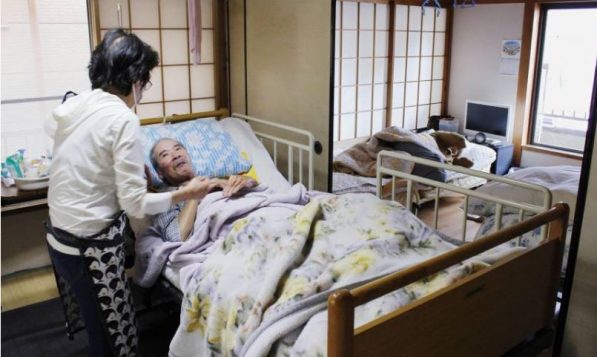The findings, from a 2015 Kyodo News survey, also showed many of these facilities didn’t meet government standards for room size or fire equipment, putting residents at risk for harm and injury.
In 2009, a fire killed 10 residents at the unregistered Tamayura nursing home in Gunma Prefecture in a case that was found to be negligence.
So why would you want to live in one?
A last resort
For many low-income and elderly Japanese without family, they have no other choice.
The average waiting time government-funded homes, known as tokuyos, has blown out to two or three years, with about 524,000 people on the waiting list in 2013.
Even once you get a place, registered aged care homes usually charge ¥200,000 to ¥300,000 a month in addition to admission fees, beyond what most pensioners can afford to pay (that’s $2600 to $3800).
Almost 20% of Japanese people over 65 are living below the poverty line, according to a 2015 OECD report.
Japan does have a long-term care insurance (LTCI) system in place. People over 40 contribute a set amount every month that goes towards the cost of their aged care when they turn 65.
However, this was only introduced in 2000 – not much help to the 5.5 million people already in aged care today.
Major staffing shortfalls
Even worse is the shortage of aged care workers in Japan. While numbers have grown from 550,000 in 2000 to 1.71 million in 2013, the Labour Ministry says for every 100 job-seekers, there are 269 positions available. It’s predicting a shortage of 377,000 workers by 2025.
It’s not a surprise though when you consider how little workers are paid. A 2015 government survey showed the average monthly wage of full-time care workers was around ¥220,000, about ¥110,000 lower than the overall industry average.
Most homes can’t afford to pay their staff more either. In April last year, the government reduced its subsidies for care facilities to try to contain the blow-out in aged care costs, estimated to hit a huge $260 billion in 2025.
These subsidies pay for 90% of residents’ care. After the cuts, nearly 60% of nursing care companies said their earnings fell, and over 40% were in the red, according to a survey by the Japan Finance Corp. Research Institute in October 2015.
Finding a solution
In June, Prime Minister Shinzo Abe’s government announced it would add 250,000 more workers by improving working conditions and increasing pay by ¥10,000 ($130) from FY2017. They also promised to house an extra 500,000 elderly by 2020 – no word on how they would finance the measures.
In Machida in western Tokyo, nursing home company Gashoen has turned to the country’s growing number of single mothers to fill the gap. At one home, they have built a dormitory where single parents can live with fixed rent, set shift times and child-minding facilities. Other regions are offering free training and financial incentives to encourage single mothers to apply for nursing roles.
The Government has also changed its traditionally-strict immigration laws, creating a new resident status category for people who pass the national care worker license exam. They have also started accepting workers from Indonesia, the Philippines and Vietnam, though only 317 passed the exam in 2015.
They’ve also relaxed the guidelines on unauthorised homes in a bid to get them to register even if they don’t meet standards, as some regions depend on them because authorised facilities are full.
The future of aged care?
Given the Australian Government cuts of $1.2 billion to aged care funding, you have to ask: could we end up with the same situation here?
While we don’t have Japan’s population, the number of Australians aged over 65 is set to double to around 25% in the next 40 years[1]. We’re also experiencing a major shortage in nursing staff. In May 2014, the shortfall of positions for graduate registered nurses throughout Australia was estimated at 3,000[2].
It’s estimated that we need to build one 130-bed aged care home every week for the next 10 years to meet demand, a target that we aren’t even close to meeting.
Suddenly the possibility of “illegal” aged care homes seems like a very real one.
See more about how Japan’s elderly are being cared for in this video here.
[1] Australia’s Demographic Challenges: Australian Government – The Treasury
[2] ‘The Aged Care Workforce in Australia’ position paper – February 2015



